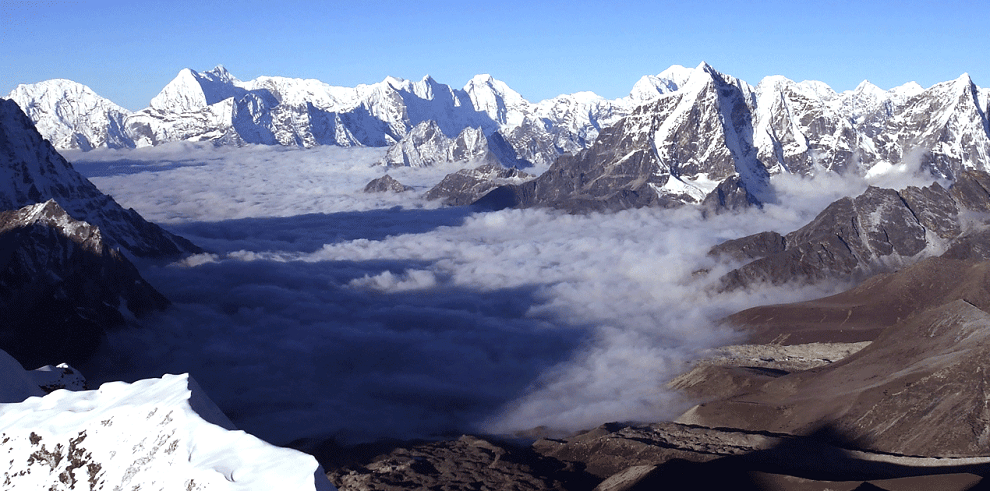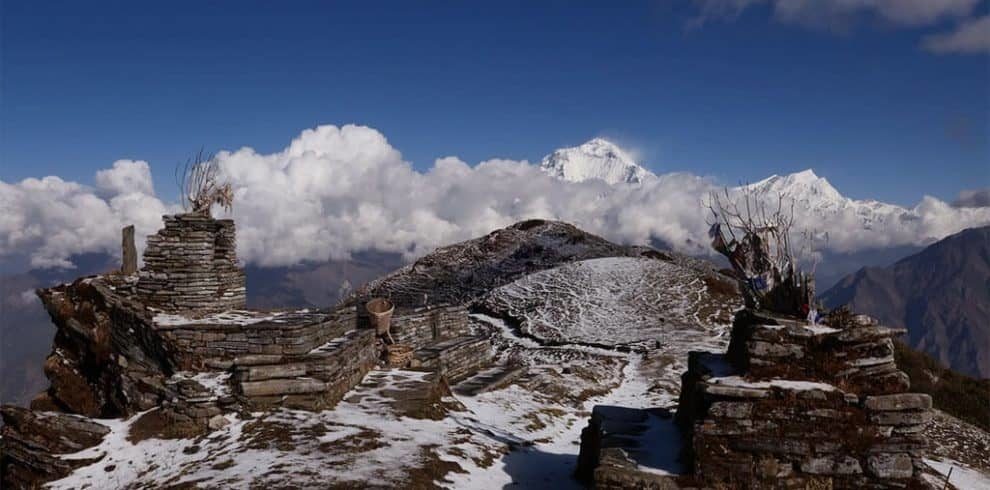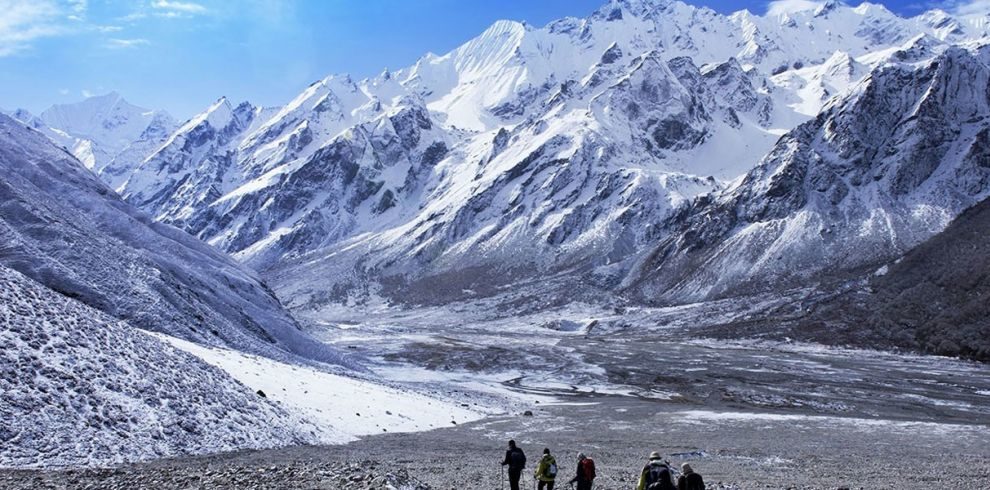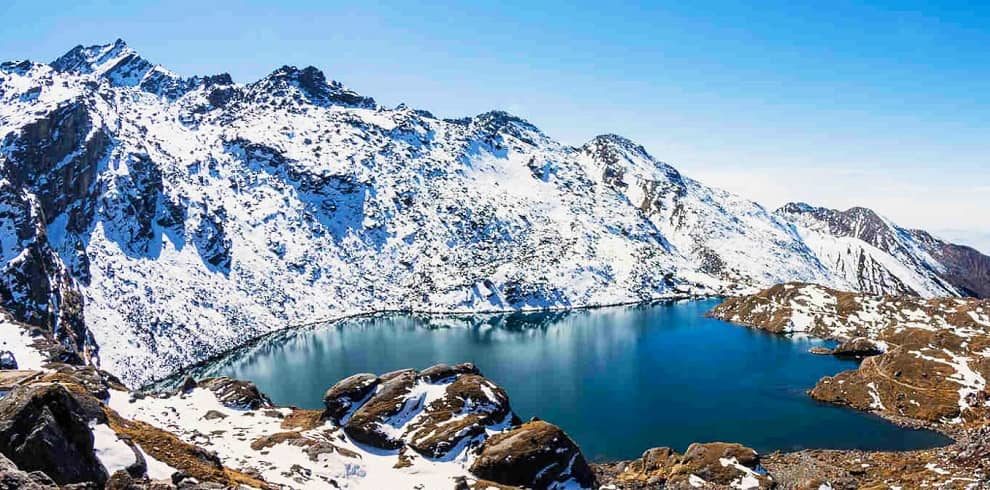Introduction Mera Peak and Island Peak Climbing via Amphu Labcha Pass In Nepal
The Mera Peak and Island Peak Climbing via Amphu Laptsa Pass combined introductory excursion provides an excellent opportunity to gain valuable mountaineering experience.
Feel the unrivaled excitement of camping in the cold wilderness to explore the untamed beauty of Island Peak (6,189m) and conquer the height of Mera Peak (6,476m), two of Nepal’s most sought-after peaks, via the isolated Hinku valley and a crossing of the breathtaking and tricky Amphu Laptsa Pass (5,780m).
Mera Mountain, at 6,476 meters, is Nepal’s highest allowed trekking peak, located south of Everest and in the densely forested Hinku valley. Island Peak, located in the Khumbu region, is a section of Lhotse Sher’s south ridge, surrounded by a spectacular view of the semicircle Nuptse Sher in the north, Cho Polo, and Makalu in the east.
Baruntse, Amphu, and Ama Dablam are to the south. Mera Peak is a less technical peak than Island Peak, despite the fact that it requires crossing very high, steep passages and a difficult summit.
In addition, the ascent to the summit of Island Peak is steeper than that of Mera.
The peaks of Chamlang, Kanchanjunga, Makalu, and Baruntse in the east, and Cho-Oyu, Ama Dablam, and Kangtega in the west provide one of the most beautiful panoramic vistas of five 8,000m summits.
To the north, Everest can be seen over Lhotse’s enormous unclimbed south face and the Nuptse ridge.
The thrilling mountain flight arrives in Lukla (a.k.a Gateway of Everest Base Camp Trek). The first days of the journey to Mera Peak take you off the usual path of Hinku valley, away from the busy Everest route.
Before starting out to scale higher heights, our Sherpa climbing guide gives instruction on various climbing tactics and skills.
Rest day at high altitude after several nights over 5,000m to ensure that you are properly acclimatized before ascending to Mera la, High Camp for the summit push.
From the highest portion of Everest’s Khumbu region, the summit of Island Peak appears to be practically at the same level as the passage of the most tricky glaciated Amphu Laptsa Pass.
A comfortable scramble, an intriguing rock ridge, and then onto a fantastic glacier with the gorgeous and breathtaking landscapes of nearby peaks Nuptse, Lhotse, Cho Oyu, Ama Dablam, and Baruntse are all part of a climb of Island Peak.
Following the Sherpa heartland, we shall descend after the ascent. From here, the path back to Lukla to complete the journey is shorter.
This excursion is for individuals who want to climb Mera Peak, then ascend the more tricky Island Peak with sufficient acclimatization and contingency days to increase their chances of reaching the summits comfortably.
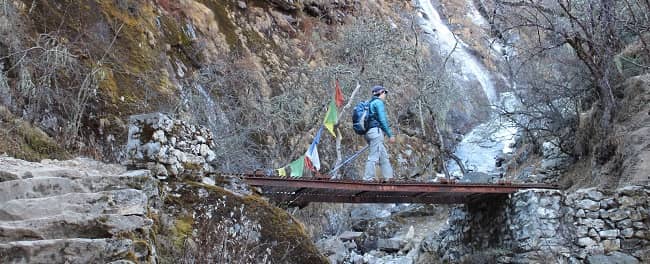
This excursion is suitable for anyone who has little or no prior experience with an ice ax and crampons, although it does necessitate a high level of physical condition.
Highlights Of Mera Peak and Island Peak Climbing via Amphu Labcha Pass In Nepal
- With sufficient acclimatization and contingency days, climb Mera and Island Peak.
- Views from the summits of two of Nepal’s iconic “trekking” peaks are breathtaking.
- Pass through the Amphu Laptsa Pass
- Trekking in the secluded Hingku valley is high and wild.
- Trekking to Namche Bazaar Sherpa Culture through the Everest region
- Visit the world heritage monuments of Pashupatinath (a prominent Hind shrine), Boudhanath (a gigantic Buddhist stupa), and Swyambhunath (a monkey temple) during a full-day sightseeing tour of Kathmandu.
- Learn how to use specialized climbing equipment.
- Beautiful glaciers will be followed.
- Discover Nepal’s breathtaking natural beauty.
The beginning of the journey towards Mera Peak and Island Peak
Don’t Worry, We’ll Pick You up!
Best Time For Mera Peak and Island Peak
Because no one is beyond nature, the weather is one of the most significant aspects to consider while determining whether or not to trek to Mera Peak and Island Peak. People climb up to Mera Peak and Island Peak all year, but there are ups and downs in every season. It is best to trek in the spring and autumn when the sky is crystal clear from night to morning, the wet weather stops, and the dense sun-blocking clouds recede. The most beautiful landscapes are created by the magic of bright azure skies. With those amazing vistas, the climate is also excellent, with the sun being warm and the atmosphere not being as cold as in other months after delving into the sun.
Although it is more difficult to travel during the winters and monsoons due to heavy snowfall and low temperatures, this is what attracts many trekkers.
The temperature changes dramatically as one climbs a mountain. The temperature drops as you climb higher in elevation. This reason’s average temperature is listed below.
Temperatures range from 9 to 21 degrees Celsius at 1500 meters altitude.
Temperatures range from 3 to 15 degrees Celsius at an elevation of 2500 meters.
Temperatures range from -4 to 7 degrees Celsius at an elevation of 3500 meters.
Temperatures range from -10 to 0 degrees Celsius at an elevation of 4500 meters.
Temperatures range from -17 to -11 degrees Celsius at an elevation of 5500 meters.
Temperatures range from -14 to -21 degrees Celsius at an elevation of 6500 meters.
The weather in the Himalayas is notoriously unreliable, with temperatures fluctuating dramatically from day to night.
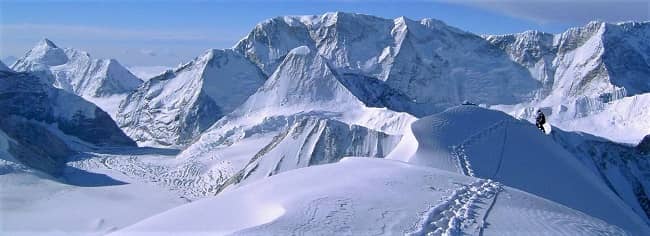
Trekking group/single
We organize both group and private treks. Group discounts are available dependent on the size of your group. The larger your group, the greater the savings. Please see our price list for further information. Simply click the – we offer group discounts – link on the right.
Having said that, we can accommodate groups of any size and even add an assistant guide for groups of 12 or more.
A typical day on the Mera Peak and Island Peak
Every day will be rewarded with a one-of-a-kind experience of walking, climbing, shooting photography, and touring the surrounding villages. We are accompanied on the adventure by experienced, pleasant, and trained professional Sherpas who provide us with information and historical facts about the locations as we travel. We’ll be escorted by the porters who will be carrying our bags. We will, however, be bringing our standard day bag pack of essentials.
The day begins with a nice cup of tea or coffee in the morning. We set off on the day’s walk from 7 AM to 8 AM, depending on the duration and nature of the day’s trek, after packing our bags and eating a hearty breakfast. Lunch will be provided at midday on the route to the next destination after three to four hours of trekking, and we will continue after roughly an hour of rest.
The trek in the afternoon is usually shorter, lasting two to three hours. We nibble on the additional dietary food once we arrive at our overnight lodge/tea house/tent. We’ll have some free time to go exploring in the area.
Dinner is served between 6 and 7 p.m. We engage in cordial chats and review the events of the day after dinner and before going to bed. The expedition leader/guide will give us an overview of the next day’s activities.
Following the briefing, we play board games such as monopoly and cards, as well as viewed accessible mountaineering documentaries. Most visitors learn the Nepalese language in a light and enjoyable manner from our personnel or read books before retiring to their beds for a well-deserved rest.
How to Communicate During the Trek?
For a nominal fee, you can use the internet at the lodges, but after you reach high elevations, you’ll have to communicate via phone.
Our office will connect with all of our valued clients by Signal, WhatsApp, phone, Messenger, and other means at least once a day to ensure that they are fine, safe, and comfortable.
You might get some signals along the route, depending on the network you’re using, but they’re not particularly strong at high altitudes. In Kathmandu, though, you may easily obtain a local sim card.
In most cases, you will be able to connect to the internet at all of the lodges/hotels where you will be staying.
Wi-Fi is usually available during the walk-in lodges/lodges for an additional fee.
Extra personal expenses on trekking
In Kathmandu, the clients are responsible for their own meals and lodging. You may book them conveniently online, or we can do it for you if you want.
Similarly, you must pay for visa processing, travel insurance, beverages, trip snacks, hot and cold drinks, souvenirs, and tips to trekking crew members, among other things. Bringing cash (Dollars) and changing it to Rupees is recommended. In the Nepali market, only Rupees are accepted.
Electricity, battery recharge, water on trekking
In all lodges, electricity for camera and phone recharge is available at an additional expense. During the trip, you can either buy pre-packaged mineral water or bring boiled water with you. You will also receive a water-purifying pill.
We advise against drinking water from rivers or taps because the water may be contaminated.
Trek travel insurance
This Trek requires travel insurance. Before beginning the hike, all trekkers must produce a copy of their comprehensive travel insurance policy certificate to us. Medical and emergency repatriation must be covered, as well as helicopter rescue and evacuation costs at high altitudes (up to 6000m).
Based on the experiences of our former clients, we may recommend insurance firms to you. We do not, however, sell insurance coverage. Within a week of booking the trek, we ask that all trek participants provide us with their comprehensive insurance information. In an emergency, we’ll prepare a speedy, successful rescue using your insurance policy and other documentation you supplied us.
Before you acquire travel insurance, call your provider and double-check that it covers helicopter rescue and evacuation up to 6000 meters. Do not rely solely on the material of the insurance company’s website.
How to get a visa for Nepal?
Except for Indian nationals, all foreigners must have a valid visa to enter Nepal. At Tribhuvan International Airport and Nepal’s borders with India and Tibet, you can obtain an on-arrival visa. Visit www.immigration.gov.np. for additional details.
You’ll need a passport that’s valid for at least six months, a passport-size photo, and visa fees to apply for a visa. A 30-day visa costs $50 at the moment (to be paid in cash).
A free visa will be given to children under the age of ten. It is strongly recommended that you examine the current regulations. Visa regulations are subject to change at any time. Citizens of China and members of the South Asian Association for Regional Cooperation (SAARC) (Bangladesh, Bhutan, India, Maldives, Pakistan, and Sri Lanka) are exempt from visa fees.
Certain countries’ citizens may be denied a visa upon arrival. On-arrival visas are not available for citizens of Nigeria, Ghana, Zimbabwe, Swaziland, Cameroon, Somalia, Liberia, Ethiopia, Iraq, Palestine, and Afghanistan. If you are a citizen of one of these countries, please contact the Nepalese Embassy in your country.
Before we embark on our journey, we’ll double-check everything (luggage, equipment, etc.) during our briefing.
Currency Exchange in Nepal | USD to NPR
Nepali Rupees (NPR/Rs) are the local currency.
(1 USD = ~ Rs.124 NPR).
You can exchange major foreign currencies through local banks and legitimate money exchanges in Kathmandu and all over Thamel. Legitimate money exchanges display their ongoing exchange rates visibly to the public.
Please note – only 100 INR (Indian Rupees) and 2000 INR notes are legal in Nepal.
Despite having the security advantage of traveler’s cheques, we prefer cash exchange. It helps avoid lengthy processes and high bank commissions.
You can withdraw cash (in Rupees)from ATMs all over Kathmandu and Thamel itself. Many of these ATMs are open around the clock. The maximum withdrawal amount is 35,000 Rupees for a 500 Rupees processing fee for foreign cards.
If you use the money exchange facilities at banks and financial institutions, they impose a service charge fee of about 4% or more.
During the trek, there are no banks and money exchange services so you should exchange your money in Kathmandu, depending on how much personal expense you require. Only Nepali Rupee is accepted in trekking regions.
Most established banks in Asia will only accept foreign currency notes that are not old, torn, or faded. Please ensure that you have new, clean notes.
How much luggage can I take during the Trek?
Your luggage must not exceed 9 kilograms per trekker. One porter will be allocated to each of the two trekkers, and the total weight of their luggage should not exceed 18 kg. Our porters are never overworked.
You may, however, need to bring your own knapsack or backpack (with valuables or anything important). Carry only what you need. Excess baggage can be safely stored at your hotel or at our store for no charge.
Before we begin the journey, we will double-check everything (luggage, equipment, etc.) during our briefing.
Trek Safely
All of our clients’ safety, security, and happiness are guaranteed by us. We place the highest priority on your safety. For each trip, we will bring all of the essential gear, equipment, and first-aid kits. Our guides and leaders have completed thorough first-aid training.
If a trekker becomes ill as a result of the altitude, we will analyze the situation and keep everyone safe. In the event of an emergency, the rescue chopper will be on standby to transport you back to the lower elevation. Every team member will be together for safety during the walk, and there will be no danger of being lost in hazardous terrains.
Responsible travel
Our philosophy is to photograph the voyage while leaving only footsteps. We believe in sustainable tourism and exclusively offer eco-friendly excursions.
We collaborate with the Kathmandu Environmental Education Project (KEEP) to plan eco-friendly itineraries that satisfy the needs of both tourists and local populations in the trekking areas.
Our Crew
Our knowledgeable guide/Sherpa will accompany us on the trek to ensure your safety and comfort. Your stuff will be carried by porters.
Our members are locals from high Himalayan remote places, and they have exceptional physical endurance at high altitudes.
We value all of our employees, so we pay them well and take care of their insurance, clothing, food, and lodging throughout the trip. When our guides and porters become unwell or injured, they receive medical attention.
Only happy people can make others happy, thus we always make sure that our team members are happy. Members of our trek/expedition team have the following qualifications:
- Authorized Trekking Guide Training Certificate
- Intensive Wilderness First Aid Training
- Fluency in English and another major language
- Conservation and Biodiversity Training
- Experience with rock climbing
Tipping during trek
Tipping is optional and should be dependent on the quality of service received. A tip is an accepted and respected technique in Nepali society to express gratitude (Dhanyabad) for good service.
On the last day of the walk, the majority of our guests offer advice. The amount you tip is totally up to you, and it may be more or less based on your impression of service quality, the length of your trip, your budget, and your appreciation for their efforts.
100% Guaranteed Booking
We are a government-approved and bonded trek and tour company in Nepal. We are also members of the Nepal Mountaineering Association (NMA) and the Trekking Agency Association of Nepal (TAAN) (NMA). As a result, you may book your trek/expedition with complete trust.
As a deposit, we require 10% of the total trip cost. Within a week of booking, please send your documentation, including a copy of your passport, passport-size pictures, travel insurance policy, and arrival and departure flight information.
You can make a 10% deposit via bank transfer, western union, or online payment on our website, and the full balance when you arrive in Nepal. Cash, bank transfer, and credit cards are all acceptable methods of payment. In addition, you will receive payment choices in your email.
Last-minute Trek booking in Nepal
Even though it is always a good idea to plan ahead for your excursions. However, for those who are unable to do so, we provide a special last-minute booking option. To take advantage of this benefit, you must pay the entire trip cost 24 hours before the trek’s departure.
Even while we do our best to plan treks at any time, there is a small potential of a trek delay due to events beyond our control, such as the inability to obtain air tickets or unfavorable weather.
Can I extend my trip?
If you wish to stay in Nepal for a few days after the trip, we can arrange enjoyable activities for you, such as exploring areas in and around Kathmandu, Chitwan jungle safari, paragliding, rafting, canoeing, and so on.
Feedback
We offer a farewell meal at the end of the trek, and we will also award you with a trek completion certificate after dinner (hard copy). It’s also a great opportunity to tell us about your experience and provide us feedback.
You may also visit Rara Lake Trek-Cost, Distance, Itinerary, In Nepal – 15 Days
Overview Of Mera Peak and Island Peak Climbing via Amphu Laptsa Pass
- The Mera Peak Climbing and Amphu Labcha pass consists of Nepal’s most popular peak, Mera, with spectacular views of the high Himalayan panorama, crossing the difficult Amphu Lapcha La Pass, exploring Honku valley, Honku glacier, large frozen lakes, and Pachpokhari (five lakes).
- The Island Peak Climbing expedition takes you from the bustling and hustling Namche Bazaar in Everest, Nepal, to the stunning Dingboche at 4,352m via the Sherpa capital of the bustling and hustling Dingboche at 4,352m.
- An exciting mountaineering expedition to Island Peak (6,189m), one of Nepal’s most popular trekking peaks, for breathtaking panoramic views of five of the world’s top ten highest 8,000m mountains; Everest, Lhotse, Kanchanjunga, Makalu, and Cho-Oyu, via the high spectacular and challenging Amphu Laptsa Pass in the Himalayas- an ultimate diverse climbing adventure leading to a
